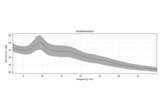mne.time_frequency.psd_multitaper¶
- mne.time_frequency.psd_multitaper(inst, fmin=0, fmax=inf, tmin=None, tmax=None, bandwidth=None, adaptive=False, low_bias=True, normalization='length', picks=None, proj=False, n_jobs=1, reject_by_annotation=False, verbose=None)[source]¶
Compute the power spectral density (PSD) using multitapers.
Calculates spectral density for orthogonal tapers, then averages them together for each channel/epoch. See 1 for a description of the tapers and 2 for the general method.
- Parameters
- instinstance of
EpochsorRaworEvoked The data for PSD calculation.
- fmin
float Min frequency of interest.
- fmax
float Max frequency of interest.
- tmin
float|None Min time of interest.
- tmax
float|None Max time of interest.
- bandwidth
float The bandwidth of the multi taper windowing function in Hz. The default value is a window half-bandwidth of 4.
- adaptivebool
Use adaptive weights to combine the tapered spectra into PSD (slow, use n_jobs >> 1 to speed up computation).
- low_biasbool
Only use tapers with more than 90% spectral concentration within bandwidth.
- normalization
str Either “full” or “length” (default). If “full”, the PSD will be normalized by the sampling rate as well as the length of the signal (as in nitime).
- picks
str|list|slice|None Channels to include. Slices and lists of integers will be interpreted as channel indices. In lists, channel type strings (e.g.,
['meg', 'eeg']) will pick channels of those types, channel name strings (e.g.,['MEG0111', 'MEG2623']will pick the given channels. Can also be the string values “all” to pick all channels, or “data” to pick data channels. None (default) will pick good data channels (excluding reference MEG channels). Note that channels ininfo['bads']will be included if their names or indices are explicitly provided.- projbool
Apply SSP projection vectors. If inst is ndarray this is not used.
- n_jobs
int The number of jobs to run in parallel (default
1). If-1, it is set to the number of CPU cores. Requires thejoblibpackage.- reject_by_annotationbool
Whether to omit bad segments from the data before fitting. If
True(default), annotated segments whose description begins with'bad'are omitted. IfFalse, no rejection based on annotations is performed.Has no effect if
instis not amne.io.Rawobject.- verbosebool |
str|int|None Control verbosity of the logging output. If
None, use the default verbosity level. See the logging documentation andmne.verbose()for details. Should only be passed as a keyword argument.
- instinstance of
- Returns
Notes
New in version 0.12.0.
References
- 1
David S. Slepian. Prolate spheroidal wave functions, fourier analysis, and uncertainty-V: the discrete case. Bell System Technical Journal, 57(5):1371–1430, 1978. doi:10.1002/j.1538-7305.1978.tb02104.x.
- 2
Donald B. Percival and Andrew T. Walden. Spectral Analysis for Physical Applications: Multitaper and Conventional Univariate Techniques. Cambridge University Press, Cambridge; New York, 1993. ISBN 978-0-521-35532-2. doi:10.1017/CBO9780511622762.
